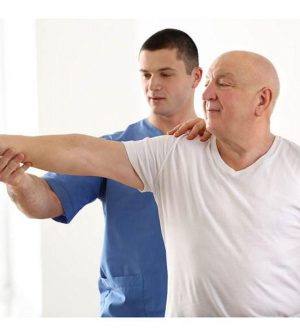- Navigating Your Midlife Crisis: Embracing New Possibilities
- City Raccoons Showing Signs of Domestication
- Mapping the Exposome: Science Broadens Focus to Environmental Disease Triggers
- One Week Less on Social Media Linked to Better Mental Health
- Your Brain Changes in Stages as You Age, Study Finds
- Some Suicide Victims Show No Typical Warning Signs, Study Finds
- ByHeart Formula Faces Lawsuits After Babies Sickened With Botulism
- Switch to Vegan Diet Could Cut Your Greenhouse Gas Emissions in Half
- Regular Bedtime Does Wonders for Blood Pressure
- Dining Alone Could Mean Worse Nutrition for Seniors
Key to Post-Stroke Recovery: Exercise

Physical activity after a stroke may be crucial to a more successful recovery, according to a study by Swedish researchers.
They found that patients who increased and sustained their exercise in the six months after their stroke were functioning better than those who didn’t.
“People who have experienced a stroke can gain functional benefits by increasing physical activity, regardless of stroke severity,” said lead researcher Dr. Dongni Buvarp of the Institute of Neuroscience and Physiology at the University of Gothenburg.
Men and patients with normal mental abilities were more likely to maintain a steady exercise regimen, regardless of the severity of their stroke, the study found.
These findings may spur ways to target people whose physical activity drops in the wake of a stroke, Buvarp said.
“This would allow an improvement of functional outcome after stroke,” she said.
At least four hours a week of light exercise is the ideal to shoot for after a stroke, Buvarp said. Activities can include riding a bike or walking, gardening, fishing, table tennis or bowling, she suggested.
“Engaging in physical activity can enhance both brain and body capacity to aid in stroke recovery,” Buvarp said. “Physical activity promotes brain plasticity and also improves recovery at the cellular level.”
She noted that an active lifestyle can boost stroke patients’ mobility and reduce their risk of falls, depression and heart disease.
“Maintaining physical activity, even at a light intensity, can contribute to better stroke recovery, regardless of stroke severity,” Buvarp added.
For the study, her team collected data on nearly 1,400 men and women (average age 72) who suffered a stroke and were part of a Swedish drug trial between October 2014 and June 2019.
Among them, 53% increased their physical activity and 47% decreased it. Those who boosted their activity over six months had better recovery of physical function, compared with those who slacked off, the findings showed.
Exercise is vital to the best recovery after a stroke, said Dr. Rohan Arora, a neurologist at LIJ-Forest Hills Hospital in Great Neck, N.J., who reviewed the findings.
Basically, you are reprograming the brain, he said.
“When you’re exercising you’re sending messages to the normal parts of the brain that are taking over for the stroke-damaged part of the brain,” Arora said. “When you do physical activity, you are trying to change the configuration of the brain.”
Exercise can include light weights, walking or any kind of machine exercise, he said.
Some patients may not be motivated to exercise after a stroke, because it’s hard to adjust to a “new normal,” Arora said. It’s part of the doctor’s job to encourage patients to be active, he added.
“When you are exercising, you are increasing the feel-good chemicals in the brain, and they will provide motivation and potentially better recovery,” Arora said.
Exercise is just one of the lifestyle changes patients need to make after a stroke to recover and reduce the odds of having another one, Arora said.
Besides exercising, these changes include not smoking, maintaining a normal body weight and eating a healthful diet.
“Physical activity is required, not just right after a stroke, but throughout your life,” Arora said. “Long-term physical activity not only helps with stroke recovery, but it also significantly reduces the risk of having another stroke or another cardiovascular event.”
The findings were published online May 1 in JAMA Network Open.
More information
For more on stroke, head to the American Stroke Association.
SOURCES: Dongni Buvarp, MD, PhD, Institute of Neuroscience and Physiology, University of Gothenburg, Sweden; Rohan Arora, MD, neurologist, Long Island Jewish (LIJ) Forest Hills Hospital, Great Neck, N.Y.; JAMA Network Open, May 1, 2023, online
Source: HealthDay
Copyright © 2025 HealthDay. All rights reserved.










